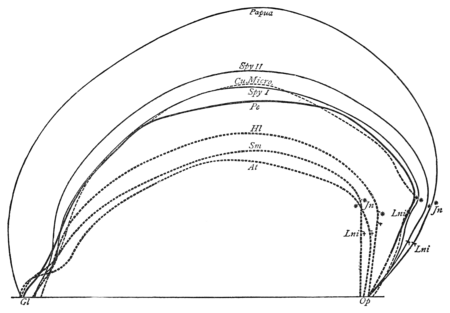however, it surpasses the maximum of anthropoids by 18°, being, nevertheless, but 9° below the Spy skull No. 2, and about 12° below the usual angle in recent human skulls.
The apes of the New World are in this respect much nearer to man than even the anthropoids. In an Ateles beelzebuth, for example, I find the angle of inclination of the nuchal surface 11°, in a Cebus niger 7° greater than the maximum of anthropoids. Indeed many other things in their cranial formation are more similar to that of man. The platyrrhines stand, however, so far from man in other respects that they are excluded from any closer comparison. In any case there is in this feature not an accidental but an essential difference between the anthropoid skull of Java and those of the anthropoid apes.
 Fig. 2.—Profile curves of the skulls of Pithecanthropus erectus (Pe), a Papuanian, the Spyman (I), Cunningham's microcephalous Joe, Hylobates leuciscus (Hl), Anthropopithecus troglodytes (At), and Semnopithecus maurus (Sm). Glabella (Gl), Opisthion (Op). Linea nuchæ superior (Jn). Linea nuchæ inferior (Lni). (Figure from Transactions of Royal Dublin Society, February, 1896.)
Fig. 2.—Profile curves of the skulls of Pithecanthropus erectus (Pe), a Papuanian, the Spyman (I), Cunningham's microcephalous Joe, Hylobates leuciscus (Hl), Anthropopithecus troglodytes (At), and Semnopithecus maurus (Sm). Glabella (Gl), Opisthion (Op). Linea nuchæ superior (Jn). Linea nuchæ inferior (Lni). (Figure from Transactions of Royal Dublin Society, February, 1896.)
In man the strong forward inclination of the nuchal portion of the occipital bone is considered to have a relation to the upright position. I can not see why it should not be interpreted in the same way in the fossil skull under consideration.
By the removal of the siliceous matter from the interior of the skullcap, which was at first partially and afterwards quite completely effected, it was shown that the sulcus transversus of the occipital bone, which, as place of attachment for the tentorium, marks the boundary between the cerebrum and the cerebellum, lies at about the same relative distance from the superior curved line of the bone as it does in the
